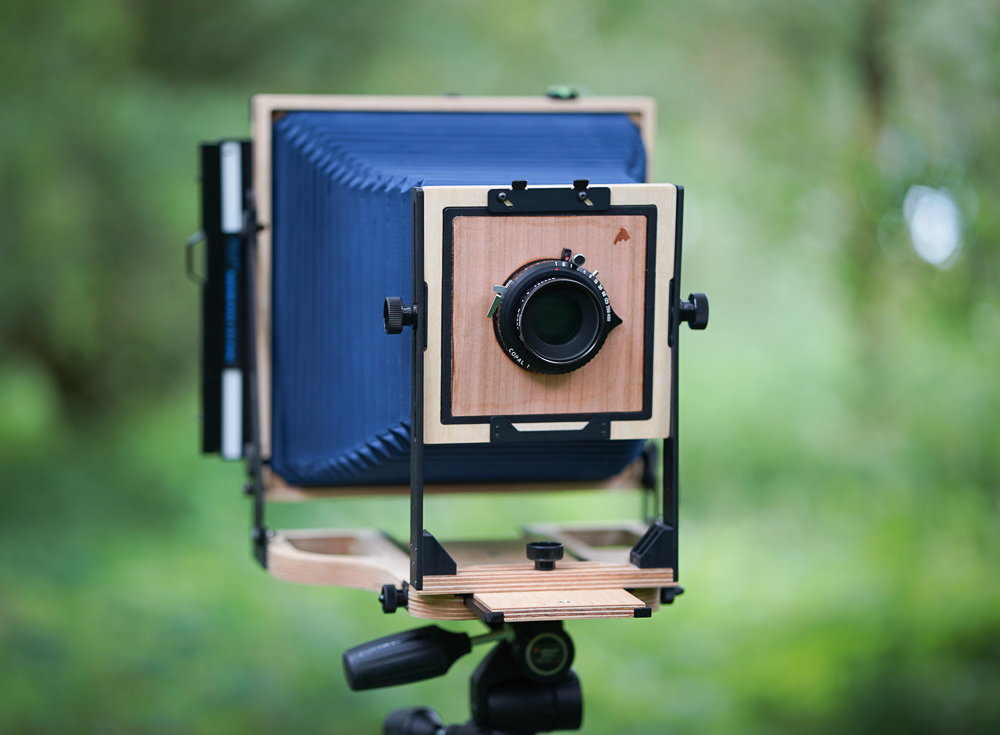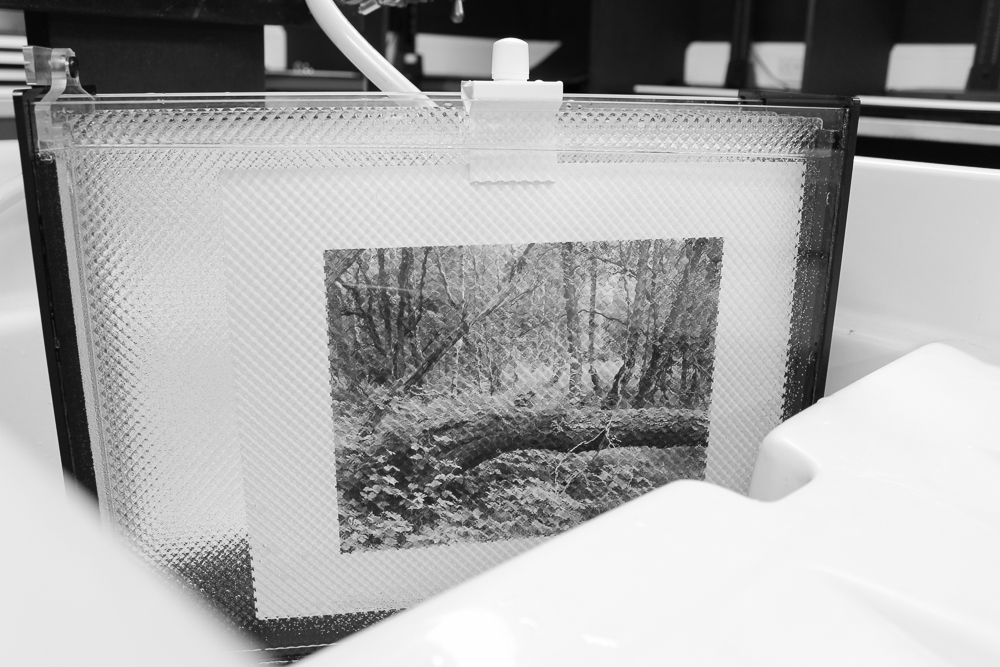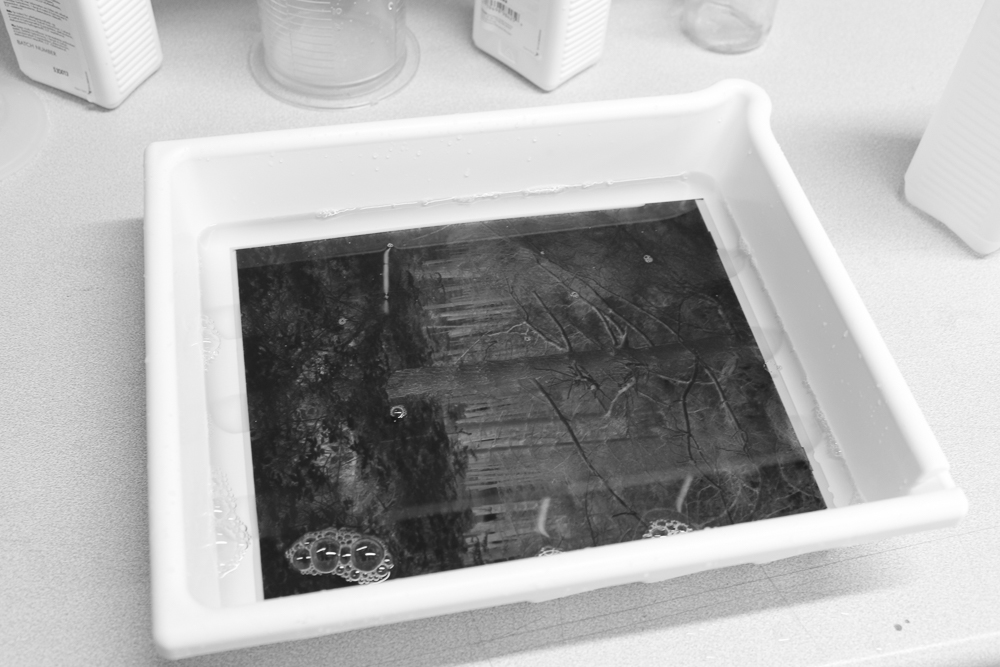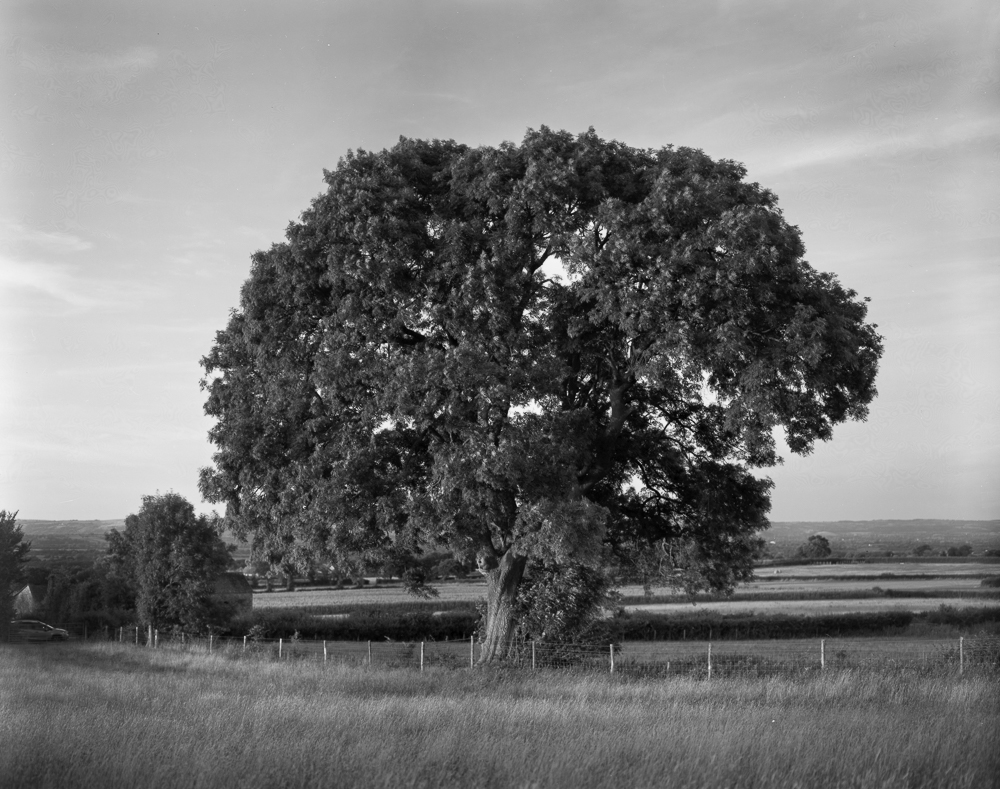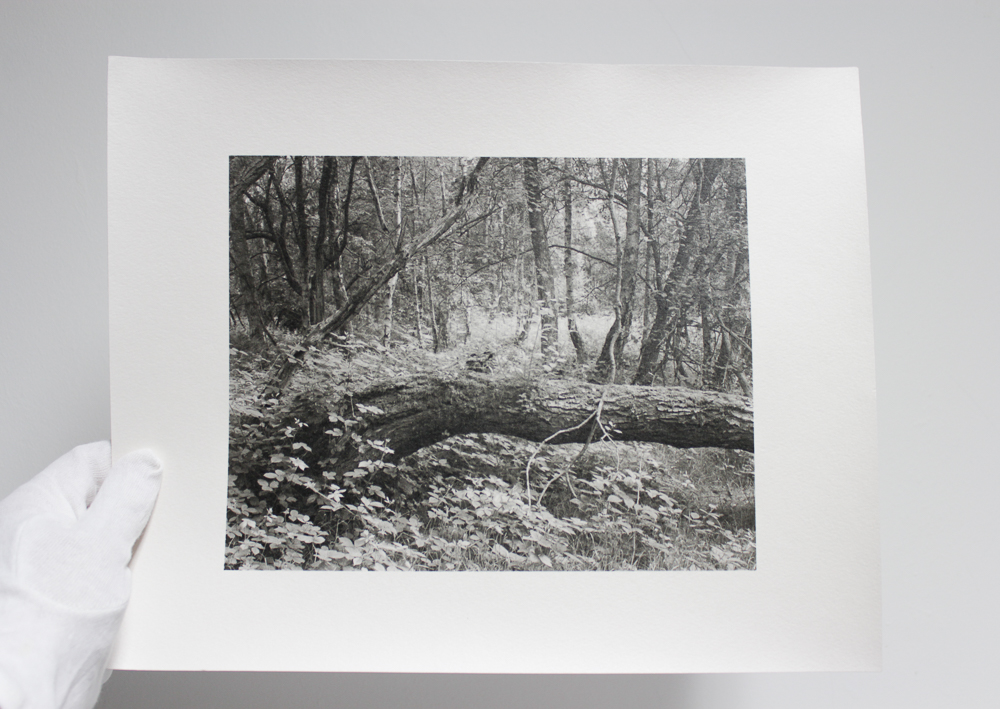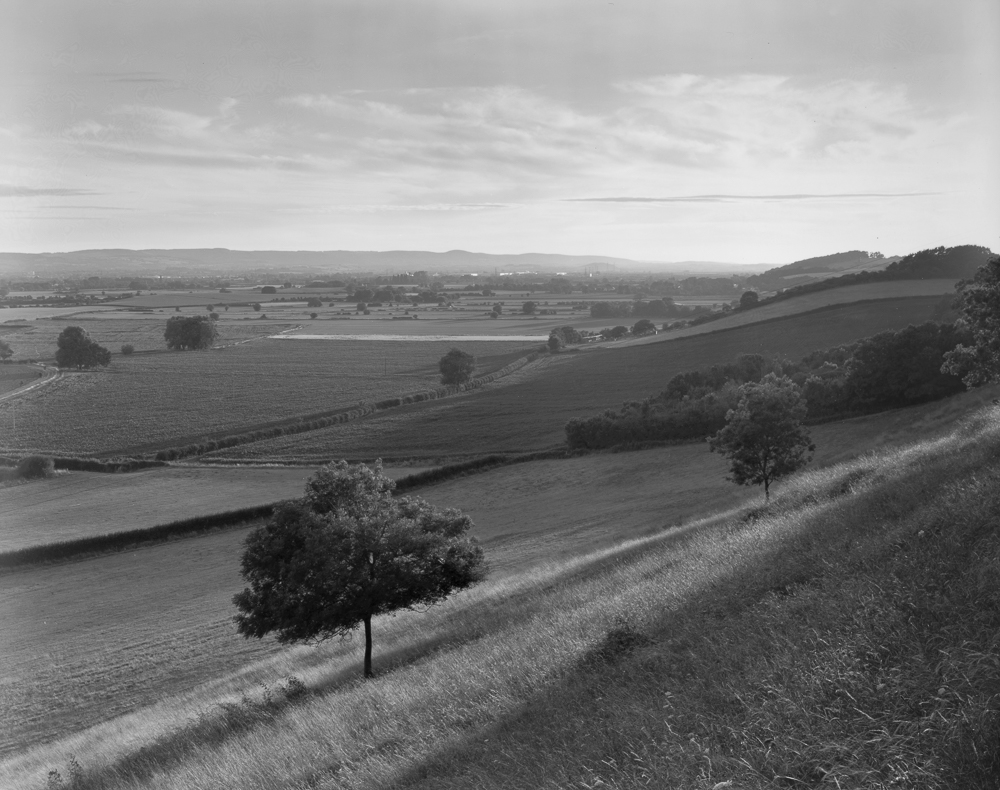I can remember my excitement when I first saw the Intrepid 10x8 Field Camera on Kickstarter. I was already very familiar with Intrepid’s 5x4 model (see my review earlier in this blog), so I felt like I knew what to expect. Yet this wasn’t 5x4, it was no ‘small’ format, it was 10x8! I started to dream of 10x8 contact prints, and felt like a little boy wishing for Christmas. It was a camera I had to have.
I duly paid my Kickstarter pledge and waited for the camera to arrive. When it came, I was immediately struck by its size. The size of cameras is of course relative, as in all things, and what may be considered large by one person in one context can be quite small in another. The 5x4 model was still fresh in my mind and hands, and it was this that began to look positively miniature by comparison. The 10x8 was a big piece of wood. It’s worth pursuing this notion of ‘largeness’, because it plays into operational considerations of weight and bulk. It’s an aspect that properly belongs in a review written for the would-be purchaser, such as this one.
The front standard with Intrepid's own lens board and logo detail.
The camera is made mainly from birch plywood with anodised metal elements. It has a front standard with swing and tilt movements, and there is some back tilt to the rear. There is a ground glass with gridlines and a beautiful etched ‘Intrepid Camera’ logo. On the top of the camera is a useful, small spirit level, and the camera is finished off with a large logo on the bottom. At the time of writing the camera is available to order in blue, black, green and red bellows. I opted for blue as I already had red in the 5x4. (I am happy with my choice, although I do rather admire the black from afar.)
On the ground glass is a beautiful etched logo. Someone has given a great deal of thought and love to this camera.
The logo on the base of the camera (with suggested destination).
There are those who are wary of plywood as the primary material, but I can’t say that I am one. There is a context here, which is the existing market for traditionally-made 10x8 cameras. There are some truly beautiful models out there, usually constructed from woods that would not be out of place in high quality furniture. These are highly precise, hand crafted cameras that last a very long time (witness the large format second-hand market). They also come at a premium. The raison d'ȇtre for the Intrepid large format models is affordable and lightweight. I have used my 5x4 quite extensively and see no deterioration in the wood. I therefore have no reason to think there will be issues with the plywood on my 10x8 in the near future. Long-term may be a different question, but you will see I refer my thinking to the important context.
The camera from the front, in the field.
Operationally, the 10x8 Intrepid is very similar to the 5x4. The camera folds to something like an 8 cm deep, one foot square for transportation. It therefore needs to be unfolded and the front and rear standards tightened into place when in use. This can be done quite quickly, and I found the 10x8 no longer to set up than the 5x4. The lens board is inserted in a similar manner, and the mechanism for holding it (a metal part with two screws) the same. Focus is by means of a knob underneath the front standard, and a parallel knob allows the lens to be secured in place once focus has been achieved.
The camera folded up. You can also see the small but useful spirit level.
There is one important difference however, and this is a product of the design of ground glass and film holder receptacle. When the camera is first unpacked, the ground glass is in portrait orientation. In the 5x4 model it can simply be turned into landscape mode, a very convenient feature made possible by clever design and the miracle of magnets. Magnets are still present in the 10x8 version, but now the user must unscrew the back, take it off, and screw it back on in the alternative orientation.
The rear of the camera in portrait orientation, with film holder inserted.
When I first looked at this I thought the design was elegant enough and didn’t pay it too much attention. I must say that having used it for a time in the field, it isn’t quite as smooth as I’d like. On my copy of the camera, some fiddling is required to marry the screws to their receiving holes. Not a big issue, but for someone like myself who likes to change from portrait to landscape frequently, a small hurdle to very smooth operation. Indeed, when I first used the camera I tended to forget that the back needed to be returned to the portrait orientation before the camera can be collapsed. You can’t close it if the back is left in landscape mode. A quirk that you learn for sure, but worthy of mention here.
A close up of the screw mechanism used to change the orientation of the ground glass. Not all 10x8 cameras can change orientation (i.e. some are fixed in either portrait or landscape), so there is an upside to this design, too.
The critical reviewer of cameras sometimes treads a fine line, especially with something like this wooden camera where there may be variations between samples. I only have the one camera, paid for by my own money, and so the reader should be warned that some of what I write may apply only to my specific example. At any rate, I know that Intrepid are extremely receptive to feedback and already have a sound track record for improving their products (the 5x4 is currently on its third iteration). I write in the spirit of critical feedback and ongoing improvement.
When I first received my camera, the focusing was not very smooth. I applied a little extra machine grease to the mechanism and ‘exercised’ it a few times to loosen it up. There is no doubt that it works fine (because I have tested it in the field), but I do still have the impression of the teeth ‘missing’, at certain points, as the focus is turned. Perhaps there is scope to add more precise metal parts to this area, which does have to move a large section of wood (by contrast the 5x4 moves a very small panel and the plastic parts have no problem at all in providing a very smooth operation).
When I made my first exposure I realised I had a light leak. At first I thought it was an issue in the darkroom, but then it struck me that the shape on my negative pointed to light inside the camera. A quick check with a torch in total darkness confirmed what I suspected, and I resolved the problem with a little glue on the bellows. I have had no light leaks since, but the incident taught me early on to check for leaks before any substantial expeditions. This is an element of good practice with large format, although Intrepid may wish to give thought in the long-run to how their bellows are attached. Perhaps a mechanism other than glue will exceed the brief and price-point of the camera, I don’t know. Again it’s worth stressing that I’m writing about my copy and other Intrepids may not see this issue.
It is important to scrutinise the camera, but now I must write of pleasures. Of the pleasures of 10x8 as a format and of using this simple, wonderful camera that looks good on the eye and even smells pleasant! There was more to my desire to shoot 10x8 than camera envy, or a wish for capricious change; I have long wanted to shoot 10x8 so that I could make contact prints. Readers of this blog will be familiar with my obsessions with the print, and indeed with the aesthetics of film, so what could be more attractive for me than the promise of a film format that could potentially deliver prints of the very highest order.
The joyous sight of a 10x8 contact print in the wash.
This review has been some time in the making because I wanted to spend time with the camera - and to spend time printing and actually making work. This I have done, and so I feel like I can write with some sound experience and insight. I have had a lot to learn beginning 10x8, and have learnt a lot. I don’t want to go too much into this here, because the danger is I will stray into writing about the format rather than the camera. However, some points are relevant, again because they speak to Intrepid’s brief and what I consider to be their success.
One of my 10x8 negatives receiving wetting agent.
If you are reading this review you may well have some sense of what might be required with 10x8, even if you have not yet tried it. 10x8 demands a commitment in planning, journeying, and physically carrying gear that other formats do not, and tolerates nothing less than impeccable craft. These are the source of its frustrations and its joys. When it is good, it is really good. Other than price, and therefore accessibility, the chief selling point of the Intrepid is its weight of 2.15 kg. A Chamonix 810V weighs 4.3 kg. (Although in fairness, they do produce a lightweight model, still heavier than the Intrepid at 2.46 kg.) I spent a long time searching for an appropriate bag / backpack (and my solution is worthy of review in its own right), but suffice it to say a good solution weighs 2kg itself. This makes a pack of roughly 4kg in weight with only a ‘standard’ focal length lens inside, and a large tripod to carry. As someone interested in landscape images, I have to wonder whether I could take 10x8 images at all with a traditional camera model. At any rate, some physical training and a re-evaluation of my sedentary ways may be in order.
The Intrepid packed away and ready for adventure.
When the Intrepid was first released there was a fair amount of discussion about its stability or lack thereof. I haven’t used the camera in any particularly challenging conditions, but I have made moderately long exposures outside and with some wind. My negatives show no evidence of camera shake. The front standard is very secure on my copy, and indeed I hadn’t thought to question its stability until I read the discussions. Perhaps for some users accustomed to heavier equipment, or who have need for longer exposures in adverse conditions, this may be more of a concern than it was to me. I am happy to report that I have made technically sound negatives with the camera, something on which I have been able to build (with no small excitement) in the darkroom.
The 10x8 format is well suited to the revealing the details of this majestic tree. Unfortunately this negative betrays an early processing mistake I made: witness the line down the right hand side from too-even tray agitation.
When I began printing, I had in mind the old adage that the harder the format is to shoot, the easier it is to print. There is a certain amount of truth in this, although I have come to look somewhat suspiciously on the oft touted idea that contact printing is more straightforward than conventional enlargement. You can see where the logic lies: gone is the enlarging stage, with its limitations of lens quality and potential dust contamination. Perhaps it is the legend of Edward Weston making beautiful prints with nothing more than a contact print maker and a humble bulb that prevails. In point of fact, I encountered several technical issues, dodging and burning can be quite a challenge on the scale and with the room afforded, dust still accrues, and my desire to make a borderless image on a larger sheet of paper necessitated hours of difficult trials with different masking solutions.
My Fallen Tree image on Ilford's sumptuous Multigrade Art darkroom paper. A version on fibre based warmtone paper is available in my shop at the time of writing.
Yet doubtless is the generous tonality and sheer visibility of the 10x8 negative. The Intrepid is a joy to compose and focus with, thanks to its bright and clear screen (limited however, it should be pointed, out by the maximum aperture of your lens). I felt I was much more in control of my image than I was with my 5x4 camera, simply because the flickering camera obscura projection is that much smaller on 5x4. This sense of control was magnified throughout the whole process: spot metering felt clearer and more decisive (I apply zone system control in processing for single images), negative inspection was a joy. I made but one studio portrait to see how the camera would function there, and the same advantages were apparent. I expect they would become even clearer with further use in the studio setting.
Hillside Tree, Somerset, Ilford HP5+ in LC29 developer.
I write this review today at a time when my 10x8 work has really started to get going. I have shared images made with the camera on social media and offered my first 10x8 darkroom print for sale on my website. I am thoroughly embroiled with this imperious format and it is in no small part thanks to the existence of Intrepid’s camera. Whether or not you have the money and inclination to buy a 10x8 Intrepid is of course your decision. Finances, circumstances and needs vary. Is the camera ‘affordable’ in the context of the large format camera market? Absolutely. Does the camera function properly and promise a proportional and sensible period of service to an industrious photographer. Without question. Is it a ‘way into’ 10x8 that I can recommend? Without hesitation.
The critical comments I have made herein are in the spirit of improvement. I offer my support to Intrepid because I like what they are trying to do and have benefited from their products in my own photography. The challenges of making affordable equipment in traditional photographic markets should not be underestimated. Witness Intrepid’s own attempts, and for the time being failure, to make a complementary affordable film holder. To paraphrase Intrepid themselves, here the company has discovered that there is a reason why some photographic equipment is traditionally so expensive. They simply couldn’t engineer a working holder at the price they envisaged.
I wouldn’t bet against them one day succeeding with the film holders. For now we have a fabulous camera and new photographic adventures to enjoy. I have to say, thanks to the Intrepid 10x8 Field Camera, this little boy’s Christmas has well and truly come early.




